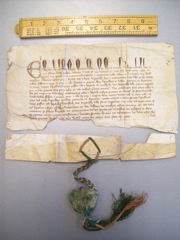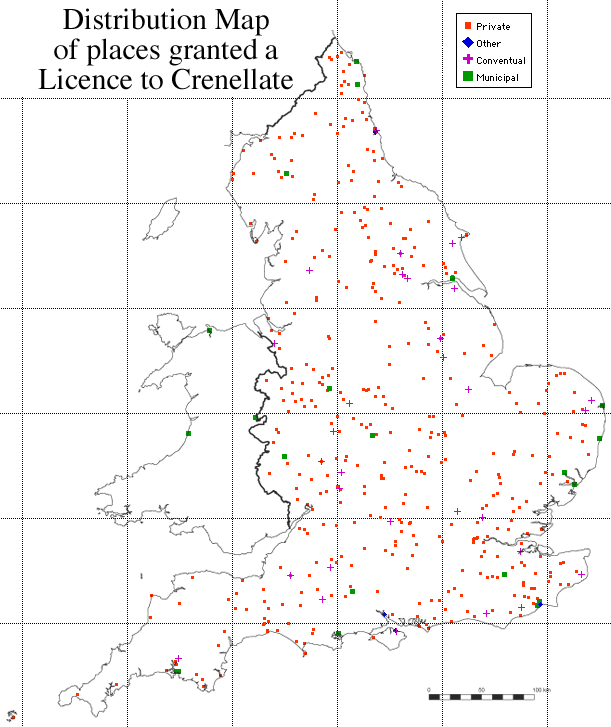A licence to crenellate was supposedly a grant that gave permission for a building to be fortified. This may have started in the Carolingian Empire as a way to control castle building to prevent local lords from becoming over mighty or too strong but, in feudal society, the licence was used both by king and baron as a symbol of their status. With "few exceptions at times of turbulence, the king's right as overlord to license was a right to grant, not to refuse, permission to crenellate" (Coulson, 1982, p71) and "In reality, no feudal or sub-feudal ruler could either in law or in practice deny to his vassal the protection by self-help fortifying which he, as lord, had failed to provide." (Coulson, 1982, p97n10) It was not in reality necessary to obtain a licence to crenellate to erect a fortified building. There was "very slight chance of interference by royal officials even in so intensively governed a realm as England, but a licence was prestigious and could be had for the asking." (Coulson, 1982, p70).3 Fortifications were not restricted by law, the cost of building and, particularly, of providing a garrison restricted true military castles to a very limited number anyway.
In England licences to crenellate were granted by the Monarch; the Bishop of Durham, in his position as ruler of the Palatinate of Durham; the Earl of Chester, in his position as ruler of the Palatinate of Cheshire and after the formation of the Palatinate of Lancashire in 1351, the Duke of Lancaster.
Few documented records survive from before the 13th century. One of the earliest supposed licence to crenellate for which some form of reliable documentation exists is one in 1141 to Geoffrey de Mandeville, Earl of Essex, made by King Stephen. This grant was repeated by Empress Matilda and named as his new castle on the Lea (novum castellum super Lviam), usually considered to be South Mymms. This is a retrospective 'grant' in complex charters obtained by Geoffrey at a time during the Anarchy, when he was able to dictate terms, and when he was imposing his noble status and it is not now considered a licence to crenellate in a meaningful sense.
Of the later surviving grants it is clear that these
were not an attempt to control the major lords but were mainly granted to relatively
minor knights for quite small manor
houses, many of which could only have had token fortifications (However,
a good number of the clerks, yeomen, squires and knights granted licences were
servants of the crown, with direct access to the king and other licences are
granted at the request of people with direct access to the king). Licences
to crenellate were mainly symbolic representations of lordly status; "castellation
was the architectural expression of noble rank" (Coulson,
1982, p72) and also "to publicly
prominent ecclesiastics and lay magnates in England a licence had the extra
cachet of royal recognition, acknowledgement and compliment. Unlike
other royal patronage it conferred no fiscal advantage whatever, but it was
as eagerly sought by the socially ambitious as any lucrative privilege." (Coulson,
1982, p83).
The
building that often, but not always, resulted from these licences, which had
some show of fortification, like battlements, moats and gatehouses, were also
mainly symbolic, although the fortifications probably represented some defence
against thieves. Coulson goes to some length to express the idea that the much
'fortification' in ecclesiastic and lay buildings was symbolic, both for the
occupants and the 'mob' they were a defence against. The gatehouse was the
most powerful symbol and the strongest part of the defence, yet mobs often
attacked the gatehouse, rather than simple push over a surrounding, relatively
weak, precinct wall. However, the gatehouse was rarely manned enough to resist
an attack anyway. In effect many 'defences' were like modern burglar alarms
and CCTV; some are sham and even when they are not they represent more an expression
of legal ownership and intent to prosecute rather than a real preventative
measure. Strong doors, good locks and fear of being caught stops thieves,
alarms may help somewhat with this last psychological barrier but, of themselves,
alarms do not stop thieves.
It has been claimed that 'only about forty licences resulted in the construction
of true castles' (my italic) (Hull, 2005, p128).
This, to my mind, shows a failure to appreciate what licences to crenellate
were and, indeed, what castles were. Bodiam and Wardour are cited as true castle
but neither of these is military. The same source writes only 13 percent of
licences were ever fully acted upon. I find this figure incredulous. The evidence
to obtain such a figure just does not exist, many sites are poorly known
and exist only as the moat of long demolished house and have not been excavated
so no date can be given for the building work. This seems to be a fundamental
error of presuming absence of evidence to be evidence of absence. I am of the
opinion that most licences did, in fact, result in significant building work
of crenellated domestic houses, which was exactly what was intended to be built
and what was licenced. The licence was not permission to build a military fortress;
a person with the power and resources to do so would not require permission.
The licence was a grant which allowed someone to show their social rank through
a symbolic building. Hull also writes "As time progressed, kings became more
reluctant to grant licences to crenellate."(ibid) There
is absolutely no evidence for this. In reality it is more probably that the
desire to apply for a licence diminished and that what the up and coming noble
wanted was not a castellated house but a deer park, something which may well
have actually required some degree of royal consent.
No fee was normally charged for licence, the handful of fees recorded are relatively small (half a mark or a mark) and are clearly to cover the bureaucratic cost of searching the records or writing the licence and not to raise money. It has been said an annual fee was required; this is due to a misinterpretation of a single reference (see Estharptree 1343). A number of licences specifically state that no fee is to taken and there is no evidence to suggest licences to crenellate were issued to raise royal revenue. Most licences were issued as patent letters granted under the privy seal.
[Note added 12 March 2010–the original patent letter to Kingston upon Hull shows such licences were written on expensive parchment with expensive silks and wax seals. This plus the parchment for the copy in the royal rolls and the scribal time means a fee of half a mark – equivalent in modern money to a few hundred pounds – would bare cover the cost of the licence and certainly not raise significant revenue.]
To fully understand licences to crenellate a widespread study is required. To this end a comprehensive list of licences to crenellate, linkable to details of all the individual sites licensed, has been compiled by me and is available as a download or online.


